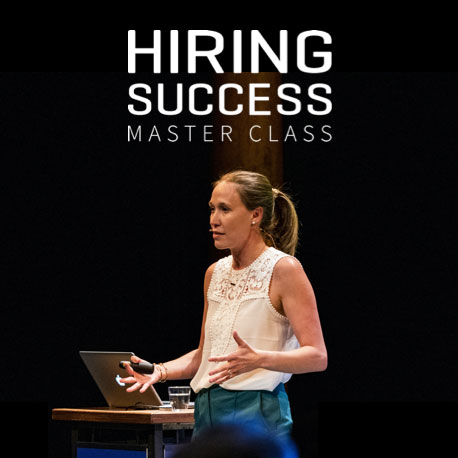It may be clear to you that your company is—or maybe has been— burning for talent acquisition (TA) transformation. Initiatives of this scale are often delayed or put off altogether because it simply isn’t the “right” time—especially in our current climate.
However, right now is an excellent time to transform talent acquisition at your organization. Hiring volumes are slowing down, which means there’s an opportunity to reassess and supercharge your strategic functions.
Now’s the time to become less transaction-focused and more attentive, ultimately, to predicting and customizing TA. Recently, I had the pleasure of discussing this topic at length in a webinar with recruiting veteran Jerome Ternynck. I’d like to summarize the key takeaways from our conversation, which will help you to build a case for TA transformation, and see how you can negotiate your way onto the right TA platform.
How to build a case for TA transformation
First thing’s first. It might be clear that you now have the time to carry out TA transformation, but do you have the funds? You must be prepared to present a proper business case for doing so, otherwise it could easily get blocked by your CFO. Unless you can demonstrate overall savings.
What are the elements of a successful business case targeted at discerning CFOs and other executives? There are four main areas to demonstrate savings through TA transformation. You’ll want to showcase them in your quest for a robust, complete talent acquisition suite.
Technology
Many companies are still relying on technology that was designed in the late nineties. When you look at a new applicant tracking system, you have to ask: What does it take to achieve hiring success?
Essentially, you have to attract the right candidates, choose the right talent, and stay organized throughout. Usually, that means you have a stack of technology above and beyond your tracking system such as a CRM, AI tools, and more.
Your first area of savings is consolidation of technology. When you modernize your architecture to use just one talent acquisition suite (TAS), you reduce the need for complexity and cost that you’re paying.

Secondly, you should consider your technology integrations, their cost and complexity. The modern talent acquisition suite helps reduce the need to pay by headcount or for access to these integrations on a piecemeal basis.
Finally, review the maintenance requirements and cost of your current technology stack. Teams often find themselves paying for full-time administration of their technology whereas a TAS reduces this need through self-serve configurations, professional services when needed, and 24/7 global support.
Sourcing
Evaluate your sourcing dollars to present a TA transformation proposal that saves money and impresses CFOs. Typically, when it comes to sourcing dollars, we mean advertising costs.
Advertising costs can be brought down in a number of ways during your transformation. For one, with the right TAS, you can easily increase your conversion rates. This means you can cut your spend while getting more candidates than before.
Then, there is the ability to predict traffic and buy traffic intelligently through automatically optimized budget allocation. You can really see which sources are producing better candidates.

Within TA transformation, you also reduce the need for a talent acquisition agency when you find you don’t have the time or resources to attract them on your own. You can cut agency costs by using a TAS that allows you to update profiles and design a portal for agencies when you need them.
For direct sourcing, there is the need to leverage CRM capabilities, and you can then convert leads and candidates with more precision and proficiency. Moreover, ask yourself whether you really need direct sourcers that rely on dated, expensive practices like cold calling.
Overall, you can save on advertising, agencies, and direct sourcing through TA transformation while increasing the number of qualified applicants in your pipeline.
People
People are the third consideration to bear in mind. There are many ways you can optimize the efficiency of your workforce, while cutting expenses and costs within your team through new processes and technologies.
Within resume screening, you can save time by using an AI screening tool to scan thousands of applicants with a click. While it won’t decide who you should interview, the technology can save you hours of work by making recommendations.

Secondly, you can maximize the efficiency and productivity of your recruiters. In general, recruiters are busy coordinating functions like feedback, candidates, interviews, and much more. In a modern TAS, recruiters are collaborating through built-in tools. They are also using workflows in scorecards and templates to maximize efficiency. And, task management means nothing falls through the cracks as you pick up speed.
Reduce repetitive tasks and circular workflows by automating processes and reduce hours needed. You can do more with fewer people with these efficiency gains. Tell your CFO about the possibilities to save here through lower employee and hourly costs.
Once you’ve reviewed the savings that are possible in technology, sourcing, and people, you can start mapping out for your CFO the cost reductions you can expect from using a modern TAS.
Cost avoidance
Cost avoidance is not money you save, but instead, money that you no longer need to spend at all under your TA transformation business case. Cost avoidance appears for talent acquisition in three main areas: mobility, flexibility, and compliance.
With mobility, you save through employee retention and redeployment. Then, you have the ability to drive transformation through a flexible platform as conditions change. When you are held accountable to data privacy standards and legal requirements, you avoid fees and fines.
How to negotiate for transformation
The agility of your technology has never been more important than it is now. When you consider how you need to shift to meet global trends and the “new normal,” you realize that technology is the key way that TA teams can attract and match talent efficiently and more helpfully.
The role of TA has evolved with current global health crises and its influence on the hiring landscape. The time is now to be more bold with more strategic tools to power the velocity and efficiency of your organization. An old infrastructure does not serve distributed teams and lacks the collaboration and flexibility needed to speed decisions.
Technology for recruiting needs to be agile to source candidates and create communities. Evolving toward a sales and marketing platform for TA leaders, you must think about leaving transactional interactions and move toward creating a candidate experience that beats the competition.

But, how do you communicate these needs and negotiate your way onto a TAS that meets the current demands and requirements? Try these two tips.
The first tip is that you must be aware of your audience. In many cases, this is the CFO who decides where to allocate resources that dictate success. Ask yourself where the business exists in terms of its primary mode of profitability and success:
- Are we about cost containment?
- Do we value higher earnings through efficiency and productivity?
- Is there a combination approach my CFO uses to balance benefits and costs?
Then, once you show your business case and its benefits, you can focus on rationalization and negotiation.
The second tip applies directly to this need for rationalization and negotiation: you must showcase a relentless focus on benefits for the business. Outline for your managers and CFO the exact nature of the savings and new capabilities that a competent TAS can bring. They won’t be able to resist once you demonstrate the hard fact that TA is changing. To stay competitive (as well as fiscally conservative), we all must focus on boosting efficiency and effectiveness.
Final thoughts
To create a transformed and reimagined talent acquisition ecosystem, understand these cost savings and benefits for your organization clearly. Once you make your case by outlining the benefits and cost savings you can bring your organization through modern technology, you are poised to become a change-maker rather than an order-taker.
For more in-depth info on how to build and implement a game-changing TA strategy, sign up for our free Hiring Success Master Class.

 Enroll in the Master Class & earn 6 SHRM credits
Enroll in the Master Class & earn 6 SHRM credits